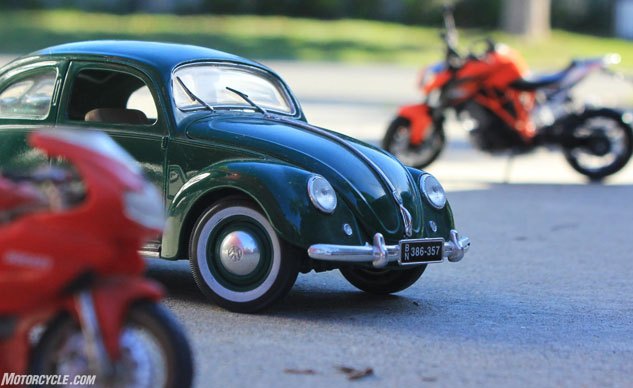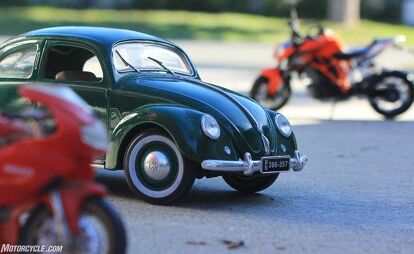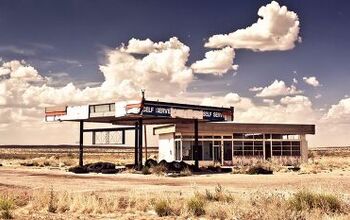Duke's Den: Motorcycles and Cars
Unlike auto drivers
Humans are odd animals. Generally speaking, they don’t like to stray far from the herd to avoid the anxiety that comes from being recognizably different than their peers. And yet there exists a potent part of society which thrives on being unconventional. As motorcycle enthusiasts, we obligate ourselves to a distinctiveness that clearly stands apart from cagers.
Now, let me state up top here that I am also able to be friends with people who don’t ride motorbikes – vehicularly speaking, I’m bi-social. I’m an appreciator of four-wheeled vehicles, especially the ones that have obvious ties to enthusiastic engineers who painstakingly developed them into sums of more than their parts. I’ve had the good fortune of being dynamically delighted by cars that range from muscle-cars and Miatas to a Fiesta ST and a Ferrari 458.
But as cool as cool cars can be, vehicles that don’t lean into turns will always have difficulty achieving the dynamic glory that motorcycles deliver. And the reward of riding is so grand that, as riders, we’re willing to overlook the penalties of motorcycling (exposure to weather and danger) that some eliminate for themselves by choosing vehicles with roofs and airbags – and lean the wrong way in corners.
But it takes a special kind of person to brave the elements and the perils associated with riding motorcycles. Motorcyclists typically aren’t “what-iffers,” as in “what bad thing could happen if we did something even slightly adventurous?” Riding motorcycles is, in many ways, an illogical activity. We may ride a couple-three hours just to get breakfast or lunch, while most cagers prefer to isolate themselves from danger and inconvenience by remaining in their quad-wheeled cocoons or in their insulating domiciles.
Providing an illustration of the different mindsets between drivers and riders is the manual transmission. Pretty much everyone who rides a motorcycle understands the rider-machine interplay of choosing the proper gear for a given situation and how being sympathetic with the torque curve of an engine makes a rider feel like he or she is in control of a living, breathing organism.
A motorbike without a clutch lever and a manually shifted gearbox is a rare thing unless you count CVTs (continuously variable transmission) as used in nearly every scooter ever built. But, to my tastes, CVTs feel too loosely connected with their engines. Honda’s dual-clutch tranny (DCT) – more clever and adept each year – is as good as it gets at this point in time for a motorcycle without a clutch lever, as its powertrain connection is 100% direct and a rider has the option of shifting whenever desired rather than it having complete automatic control.
No-Shift Shootout: 2014 Aprilia Mana GT Vs. BMW C600 Sport Vs. Honda NC700 DCT
Meanwhile, automobile drivers have nearly abandoned the kinetic art of shifting gears via hands and feet. A friend recently wanted to buy a new Honda Civic with a manual gearbox but couldn’t find one at her dealer, so she was forced to make a special order to get the six-speed tranny she coveted.
So, while car drivers abandon manuals as if they carried chlamydia, motorcyclists bravely press on heaving levers and demonstrating their mastery over their machines. Riders are forced to be – and prefer to be – active participants while sliding gracefully through the air like the pilot of a ground-bound airplane.
At the same time on the same roads are people in expensive new cars that quite literally can drive themselves, which seems to be the ideal method of conveyance to the millions of drivers who can’t be bothered to trigger a turnsignal switch let alone find joy when navigating their vehicle through time and space.
I’m not the only journalist who finds distinctions between riders and drivers. Sam Smith, an excellent writer at Road & Track magazine, noted an interesting comparison between the markets for automobiles and motorcycles.
“Motorcycles are still great,” he wrote in an editorial last summer. “Next to cars, bikes are in a much happier place. Progress and regulation have generally made new cars heavier, less disparate, and more versatile. Motorcycles have pretty much gone opposite, because who needs a bike to do everything? Or crash well, or have power seats? It’s like a parallel car universe where purity and emotion reign. Also great risk and the chance that someone will dismember you in traffic. But woof, is the emotional payoff like nothing else. To paraphrase Carl Sandburg, motorbike, I am one of your boys.”
Perhaps there’s still hope for some of the cagers out there. And for the perpetuity of manual transmissions.
Related Reading
Duke’s Den: Inside Info
Duke’s Den: Decades Of Fireblades
More by Kevin Duke


































Comments
Join the conversation
Pretty soon people will be going by in cars they are not driving and don't even own (Uber, Lyft), engrossed in their smart phones, tablets and laptops, not even looking out the window, like Zombies. The only alive people on the road will be motorcyclists.
"Perhaps there’s still hope for some of the cagers out there. And for the perpetuity of manual transmissions."
Perhaps, but I have my doubts.
Send in the drones.................... Or Flying Cages...